10 Quick Patterns to Make for Mother's Day
/Looking for a pattern to make the perfect Mother’s Day gift? Check out this list of 10 quick and easy patterns for knit, crochet and Tunisian crochet projects that your Mom will love.
Read MoreLooking for a pattern to make the perfect Mother’s Day gift? Check out this list of 10 quick and easy patterns for knit, crochet and Tunisian crochet projects that your Mom will love.
Read MoreSimple stitches and a fun little trick combine to create this beautiful Tunisian crochet texture. Add this free dishcloth pattern to your collection of handmade home items!
Read MoreLooking for a unique pattern for that recently acquired sweater quantity of yarn? The Radiant Raglan is a fun, fast and fairly easy Tunisian crochet pattern that can be customized to achieve the fit you want. I’m certain it will become your new favourite sweater!
Read MoreGrab your cotton yarn and get ready for this fun and functional textured pattern. The one-row repeat is easy to memorize, and also really simple to adjust for size.
Read MoreInspired by the rolling sand dunes of planet Arrakis (from the sci-fi/fantasy series Dune, by Frank Herbert), this beautifully textured Tunisian crochet scarf is both bold and comforting. The meditative stitch pattern makes it a great palate cleanser project, and it is easily customized for both size and yarn weight.
Read MoreThe Bridle Path Scarf is big on style and warmth. This oversized, traditional scarf is thick and cozy and works up quickly in bulky weight yarn. The instructions allow you to customize both the width and the length, so you get a scarf that is perfectly suited to your cold weather style.
Read MoreThe Stitch Exploration Series returns with textured, stripey goodness! The Speedbumps Dishcloth uses simple Tunisian crochet stitches to create little braided ridges that look like speedbumps. With a simple, one-row repeating pattern, you can easily work on this while watching your favourite tv show or sports game.
Read MoreThis quick and easy pattern makes the perfect Fall mittens! They’re warm and fuzzy without being too bulky. The unique yarn used is so soft and fluffy, you’ll be reaching for these mitts even when you don’t really need them!
Read MoreThe Parallelogram Dishcloth is the second Tunisian crochet pattern in the Stitch Exploration Series. It features a fun twist on the Tunisian Simple Stitch, and embraces the lean of the fabric to create a uniquely shaped dishcloth.
Read MoreThe Stitch Exploration Series is back, and this time we’re checking out Tunisian crochet! The Tunisian Checkerboard Dishcloth combines two basic Tunisian crochet stitches to create a very aesthetically pleasing pattern. The texture is perfect for a face cloth, too!
Read MoreThis post may contain affiliate links, meaning that if you click through and make a purchase, I earn a small commission at no extra cost to you. This helps support my business and makes it possible for me to bring you free content.
Breathe in… breathe out… Hello friends! I don’t know who else needs a few moments to just breathe, but I sure have been feeling the need to ground myself lately. This is a particularly stressful time in my life, and while crocheting brings me so much joy, the pressures (often self-inflicted) of designing patterns or keeping up with pattern testing and social media engagement can sap my cro-jo.
Recently I just picked up my hook and some pretty yarn and I started stitching. Before long, the stitches told me what they should be, and the Easy Stitches Pillow pattern was born.

This pattern is so simple, and it allows you to get into a nice, meditative rhythm while you stitch. It’s a good one for taking on the go, since it’s not too big to stash in a cute project bag. It’s also great for getting in a just few rows here and there, if you don’t have a big chunk of free time to devote to crocheting.
For this pattern, I’ve used a really cool yarn from one of my favourite companies, Lion Brand Yarn. It’s called Twisted Cotton Blend, and it’s a Bulky (5) weight blend of 69% cotton/31% acrylic. At first I thought it was going to be splitty, but I was pleasantly surprised - it is sturdy and really easy to work with. The unique texture makes it great for patterns like this that use simple stitches. The two-tone look really gives this pillow design depth, making it a perfect addition to both cozy reading corners and upscale sitting room decor.
Hook - US L/8mm Tunisian Crochet hook with 16”/40.5cm cord attached (or size needed to meet gauge). I use these ones from WeCrochet!
Yarn - approx. 600 yds/ 549m of Lion Brand Twisted Cotton Blend (I used the colour Ecru/Tan) or another Bulky (5) weight yarn of your choice.
Notions - 16”/40.5cm square pillow form, 4 buttons of any size (1”/2.5cm is recommended), locking stitch markers (2-4), scissors, tape measure, yarn needle.
The first loop on your hook to start each row counts as a stitch.
If you wish to block your work to settle the stitches, I recommend a gentle steam blocking prior to assembly.
Gauge: 12 sts x 15 rows = 4”/10cm in tks.
Measurement before assembly: approx. 40”/ 101.5cm long x 17.5”/44.5cm wide.
The finished pillow cover will fit snugly on a 16”/40.5cm square pillow form.
This pattern uses standard US terms as detailed by the Craft Yarn Council:
ch: chain
lts: last Tunisian stitch – the very last stitch of the row; insert your hook under both loops of the edge stitch
RetP: return pass – Ch 1, *yarn over and pull through 2 loops. Repeat from * until 1 loop remains on your hook
sc: single crochet
sl st: slip stitch
st(s): stitch(es)
tks: Tunisian Knit stitch – insert your hook into the middle of the stitch. Check out this excellent tutorial video!
Row 1. Ch 53. Starting in the second ch from hook, pull up a loop in the back bumps of each ch st (53 loops on hook). Work a RetP.
Row 2. Tks in each st across until the last st, lts and work a RetP.
Repeat Row 2 until your work measures approximately 40”/101.5cm long.
You will now work a bind off row, which includes small loops that will secure the buttons. You may wish to switch to a slightly smaller hook for this last row.
Bind off row: Ch 1, insert hook into next st as for tks and work a sc. Sc in next 8 sts, then work a buttonhole as follows: ch 4, join with a sl st to the last sc worked. *Sc next 11, work a buttonhole. Repeat from * twice more, then sc in last 10 sts (including the edge st, remember to insert your hook under both loops). Fasten off and proceed to Assembly instructions.
Note: make sure your buttonhole size matches the button you are using. I used a 1”/2.5cm button and cotton yarn (which does not stretch much). If you’re using yarn that has more stretch, you might want to only ch 3, or if you’re using a bigger button, work more chs as needed.
Assembly: Refer to the photos below when following along with the assembly instructions.

Lay your work flat out, right side facing down. Fold the starting edge in, then fold the buttonhole edge over the starting edge to form a square that is approximately 17”/43cm in length, with about 3”/7.5cm of overlap of the two ends (picture A). Secure the sides where these edges overlap (picture B). Turn the pillow inside out, and *starting at one corner, seam one side closed using the whip stitch, or your favourite seaming method. Make sure to go through both edges (picture C), and all three thicknesses where they overlap. Fasten off at the opposite corner. Repeat from * on the other side of the pillow.
Turn the pillow right side out. Insert the pillow form, and gently pull the buttonhole edge up over the other edge to see where the buttons should be placed. When buttoned closed, the edges should not gape or look too stretched. Place your buttons evenly so they match up with the buttonholes, and secure them in place (picture D).

Save this pattern to your Ravelry queue, or add a project to the pattern page!
Congratulations on finishing your Easy Stitches Pillow! Share your photos on Instagram using the hashtags #EasyStitchesPillow and tag me, @capital.crochet!
My patterns and thoroughly tested and edited, and come with my full support - if you find an error or have a question, please don’t hesitate to get in touch! You may sell finished items made from this pattern, but please credit me as the designer by linking back to this blog post.
Thank you so much for your support! If you’d like to be the first to know about new patterns, blog posts, and freebies (yay!), please join the email list below.
If you enjoy working with cotton yarn, check out my Stitch Exploration Series! Each month, I try out a new-to-me stitch pattern or technique, and create FREE cotton dishcloth patterns so that you can try out new skills, too! Below are the two most recent patterns in the series, March’s Pollyanna Dishcloth and February’s Mulberry Dishcloth, both using WeCrochet Dishie yarn.
This post may contain affiliate links, meaning that if you click through and make a purchase, I earn a small commission at no extra cost to you. This helps support my business and makes it possible for me to bring you free content.
This unique square is part of the amazing line up of patterns in this year’s Knitter Knotter Tunisian Blanket CAL, hosted by Arunima over at www.knitterknotter.com! It’s the perfect way to use up those partial skeins and scraps while keeping the colour theme of your blanket.
What is a CAL? Well, it stands for Crochet-ALong, and as the name of this one suggests, everyone who participates in this CAL is making a blanket. Every two weeks a new 12x12”/30x30cm square pattern by a different designer will be released for free on their blog or other platforms. By the end of 2021 you’ll have made 24 completely unique Tunisian crochet squares! For further information about the CAL, including what supplies you need and the links to all the squares, check out the main blog post. While you’re there, you can also sign up to the CAL mailing list and join the Facebook group, if you’re into that!
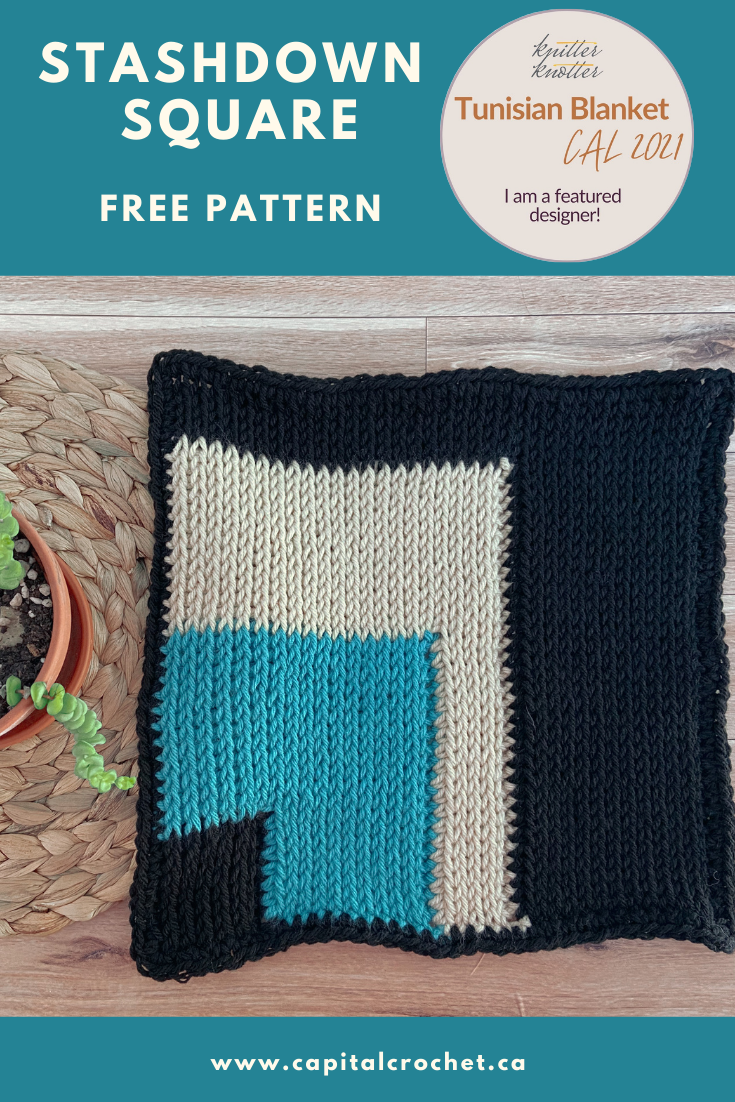
This is also a great stashbusting pattern, since you can use up bits and pieces of yarn you have laying around, and there’s no concrete yardage requirement. My samples shown here use 3 different colours, but feel free to experiment and make this square your own!
Don’t forget to grab the premium, ad-free PDF on Ravelry or in my pattern shop, as it includes a detailed photo tutorial for this pattern, along with a blank chart that you can use to fill in your own colour plan. Or, you can really go wild and just wing it - it truly is a totally customizable pattern!
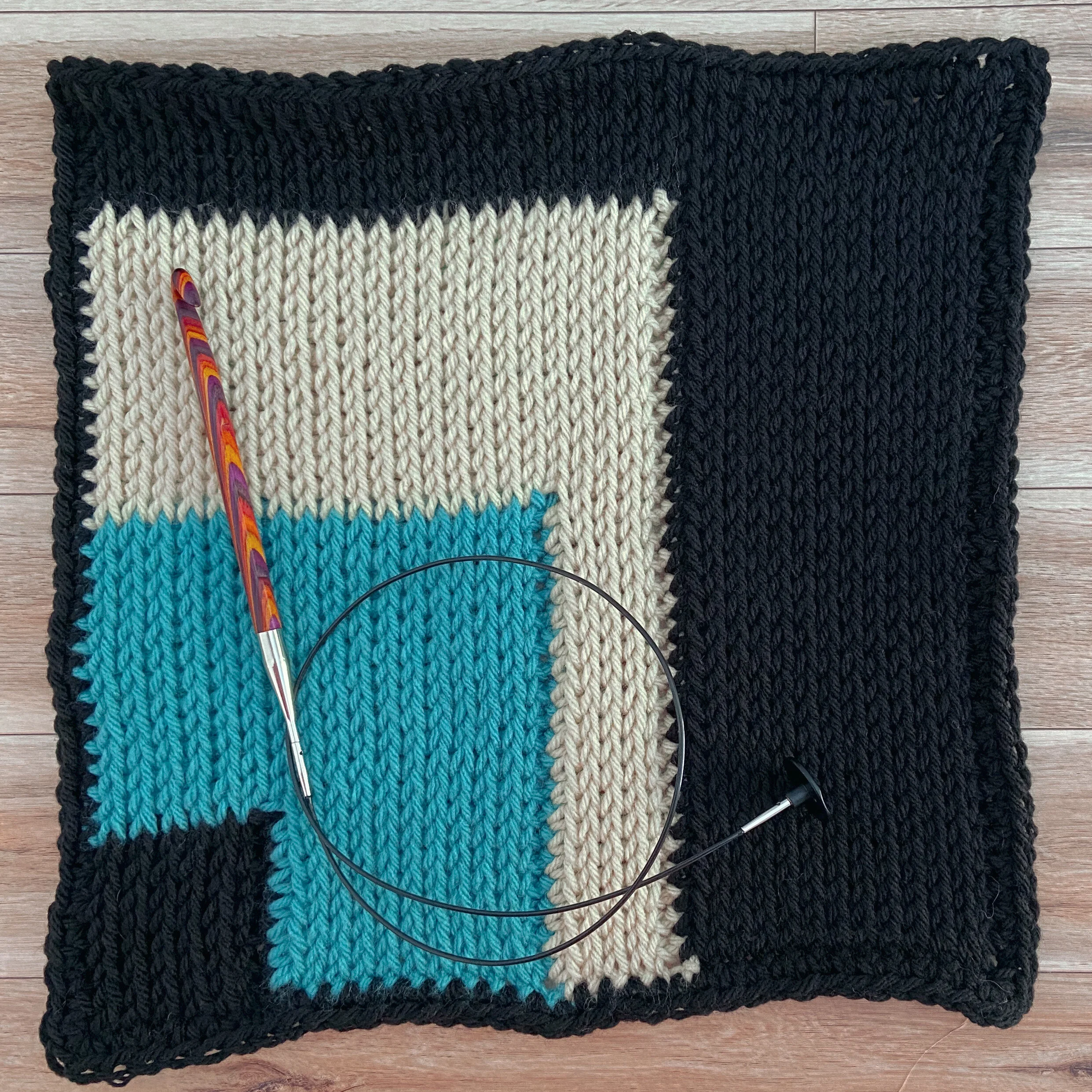
Yarn - approximately 145 yds/133m worsted (4) weight in various colours (I used 3 different colours - A, B and C - of Loops and Threads Impeccable from Michael’s Stores).
Hooks - L/11 8mm Tunisian crochet hook with 12”/30cm cord (or hook needed to meet gauge) – you will use this hook for the main part of the square; AND 7mm regular crochet hook (or two sizes/1mm down from the hook that meets gauge) – you will use this hook for the bind off row and the border. I use the Radiant Wood Interchangeable Hooks from WeCrochet, and I love them!
Notions - locking stitch marker (1), scissors, tape measure, yarn needle, blocking mats and pins.
The square is worked in four sections using the JAYG technique. The Pattern Instructions and Colour Chart shown below will create the square exactly as pictured. The premium, ad-free PDF has a blank chart that can be coloured in with your own custom colours, so you can vary the placement and size of your colour blocks and create unique squares with as many colours as you like!
The remaining loop on your hook after the RetP is the first stitch of each row, and is not included in the stitch count instruction (i.e., tks next 10 = the first loop is already on your hook, then work a tks in the next 10 sts, for a total of 11 loops on hook).
When you work the last (edge) st of each row, insert your hook under both vertical bars.
Gauge: 12 sts x 14 rows = 4”/10cm in tks, blocked
Finished Measurements: approximately 12 x 12”/30 x 30cm
This pattern uses standard US terms as detailed by the Craft Yarn Council:
ch: chain
st(s): stitch(es)
sl st: slip stitch
sc: single crochet
tks: Tunisian knit stitch (insert hook between two vertical bars and pull up a loop)
JAYG: join as you go (working your square in sections)
RetP: return pass
Regular: ch 1, *yarn over, pull through 2 loops. Repeat from * until 1 loop remains on hook
JAYG: join yarn to first st of previous section, *yarn over, pull through 2 loops. Repeat from * until 1 loop remains on hook
RS/WS: right side/wrong side
Colour A: Black Colour B: Teal Colour C: Cream

The numbers at the bottom of the chart represent the number of stitches in each section. Overall, the square is 36 stitches wide.
If your gauge is very different from mine, feel free to add or remove sts and/or rows from the fourth section in order to meet the finished measurements.
Sections
First Section (Colour A, Black)
Row 1: With larger hook, ch 7. Starting in the second ch from hook, pull up a loop in the back bump of each ch st (7 loops on hook). Complete a Regular RetP.
Rows 2-7: Tks each st, complete a Regular RetP.
Row 8: Tks each st. Work the Regular RetP until 2 loops remain on your hook. Place these 2 loops on a stitch marker and cut yarn, leaving a 4” tail.
Second Section (Colour B, Teal)
Row 1: Join B as per JAYG instructions and ch 11. Starting in the second ch from hook, pull up a loop in the back bump of each ch st (11 loops on hook). Complete a JAYG RetP.
Rows 2-8: Tks in each st, complete a JAYG RetP.
Row 9: Tks in next 10 sts, then place both loops of A on your hook. With B, yarn over and pull through both loops of A. Continue working tks across the top of the first section with B, then complete a Regular RetP.
Rows 10-20: Tks each st, complete a Regular RetP.
Row 21: Tks each st. Work the Regular RetP until 2 loops remain on your hook. Place these 2 loops on a stitch marker and cut yarn, leaving a 4” tail.
Third Section (Colour C, Cream)
Row 1: Join C as per JAYG instructions and ch 5. Starting in the second ch from hook, pull up a loop in the back bump of each ch st (5 loops on hook). Complete a JAYG RetP.
Rows 2-21: Tks in each st, complete a JAYG RetP.
Row 22: Tks in next 4 sts, then place both loops of B on your hook. With C, yarn over and pull through both loops of B. Continue working tks across the top of the second section with C, then complete a Regular RetP.
Rows 23-33: Tks in each st, complete a Regular RetP.
Row 34: Tks each st. Work the Regular RetP until 2 loops remain on your hook. Place these 2 loops on a stitch marker and cut yarn, leaving a 4” tail.
Fourth Section (Colour A, Black)
Row 1: Join A as per JAYG instructions and ch 13. Starting in the second ch from hook, pull up a loop in the back bump of each ch st (13 loops on hook). Complete a JAYG RetP.
Rows 2-34: Tks in each st, complete a JAYG RetP.
Row 35: Tks in next 12 sts, then place both loops of C on your hook. With A, yarn over and pull through both loops of C. Continue working tks across the top of the third section with A, then complete a Regular RetP.
Rows 36-39: Tks in each st, complete a Regular RetP.
Do not fasten off Colour A, switch to smaller hook and proceed to Border.
Border
Bind off row: Ch 1, *insert hook into next st as for tks and work a sc st. Repeat from * across the row, until the last st. In the last st, work 3 sc.
Rotate your square to work along the side edge, RS facing up. In the end of each row, work a sc st until you reach the last row. In this row, work 3 sc and rotate your square to work along the bottom. Sc in each ch st from the foundation ch until you reach the last st. Work 3 sc in this last st and rotate your square to work up the other side. In the first st of each row, work a sc until you reach the last row. Sl st to join to the ch-1 space of the Bind off row, and fasten off.
Finishing
Block your square using your preferred method. If you’ve used an acrylic yarn (like I have), or if you find that the edges of your square are curling quite a bit, I recommend a full wet block: soak your square for 15-20 minutes in the sink or a tub of lukewarm water and a bit of wool wash. Drain and gently squeeze out as much water as you can (do not wring or stretch). Lay the square flat on a towel, and either fold the towel up or roll it neatly, then step on it to draw the rest of the water out of the square. Lay it out flat, and you may pin the edges if you like to help the stitches settle. Leave pinned until completely dry.
When your square is dry, weave in all ends to the WS. I like to save this until the very end, so that there’s no chance of puckering or pulling during the blocking process.

Congratulations on finishing the Stashdown Square pattern! I hope this customizable pattern helps you use up your scraps to make a beautifully coordinated square that fits nicely with the rest of your blanket. You could even make a few different ones to tie the whole thing together!
If you share your project on social media, don’t forget to tag me @capital.crochet and @knitterknotter, and use the hashtags #StashdownSquare and #KnitterKnotterTunisianBlanketCAL2021!
You may sell finished items made from this pattern, but please credit me as the designer by linking back to this blog post.
Thank you so much for your support! If you’d like to be the first to know about free patterns and other exciting news, make sure to subscribe to the newsletter below.
Save this pattern to your Ravelry queue, or add a project to the pattern page!
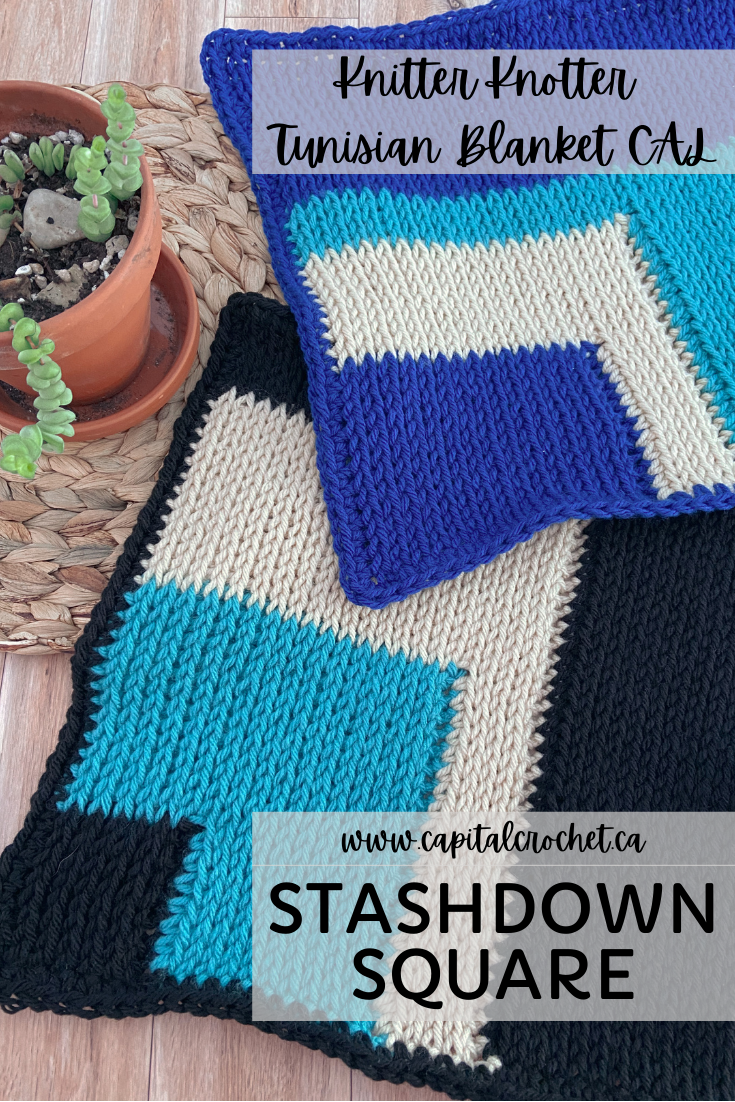
This post may contain affiliate links, meaning that if you click through and make a purchase, I earn a small commission at no extra cost to you. This helps support my business and makes it possible for me to bring you free content.
Hello friends! We’ve made it to the final pattern in the Winter Sparkle series - the Winter Sparkle Scarf!
Towards the end of November, when the days started to get real short and dark, I was sitting in my craft room one gloomy afternoon. I felt bleh, you know, lots I should be doing, no motivation to do anything. Yeah, that was me. Up on my shelf, I caught a glimpse of some Winter Nights yarn and thought, heck yes, gimme some sparkle!

The Winter Sparkle patterns are really fun, because they use two yarns held double to create a unique texture and colour look. The Winter Sparkle Scarf is a relaxing, meditative make that you can easily finish in a Netflix bing sesh or two. Match it up with the other patterns from the Winter Sparkle series, and you’ve got yourself a beautifully coordinated set!
I used Lion Brand Winter Nights for the sparkly yarn, and paired it with Lion Brand Touch of Alpaca. This gives the cowl warmth and comfort.
The pattern uses the Tunisian Simple Stitch, which is the basic Tunisian crochet stitch. It is the perfect stitch to introduce yourself to the fabulous world of Tunisian crochet!
Hook - US 10mm, or size needed to meet gauge, and a short cord attached. I love these interchangeable hooks and cords from WeCrochet.
Yarn - Lion Brand Touch of Alpaca (I used the colour Oxford Grey) and Lion Brand Winter Nights (I used the colour Chinchilly). You will need approx. 270 yds of each yarn. You may also combine any two worsted (4) weight yarns, or use a bulky (5) yarn on its own, as long as you can meet gauge.
Notions - scissors, tape measure, yarn needle, blocking pins and mat (optional).
Curling at the edges of Tunisian crochet is common. See the Finishing section below for blocking instructions to help tame the curl.
I’ve made the Infinity scarf version - see the Variations section at the end of the pattern for instructions on how to adjust the size and fit.
Gauge - 4” = 8.5 sts x 8 rows in tss unblocked.
Finished measurements - approx. 8” wide x 64” long (prior to seaming, if making the infinity version).
This pattern uses standard US terms as detailed by the Craft Yarn Council:
Ch - chain
St(s) - stitch(es)
Sl st - slip stitch
Tss - Tunisian Simple Stitch (see HERE for an excellent tutorial!)
Lts - Last Tunisian Stitch (insert hook under both bars)
RetP - Return Pass (Ch 1, *yarn over, pull through 2 loops. Repeat from * until 1 loop remains on your hook)

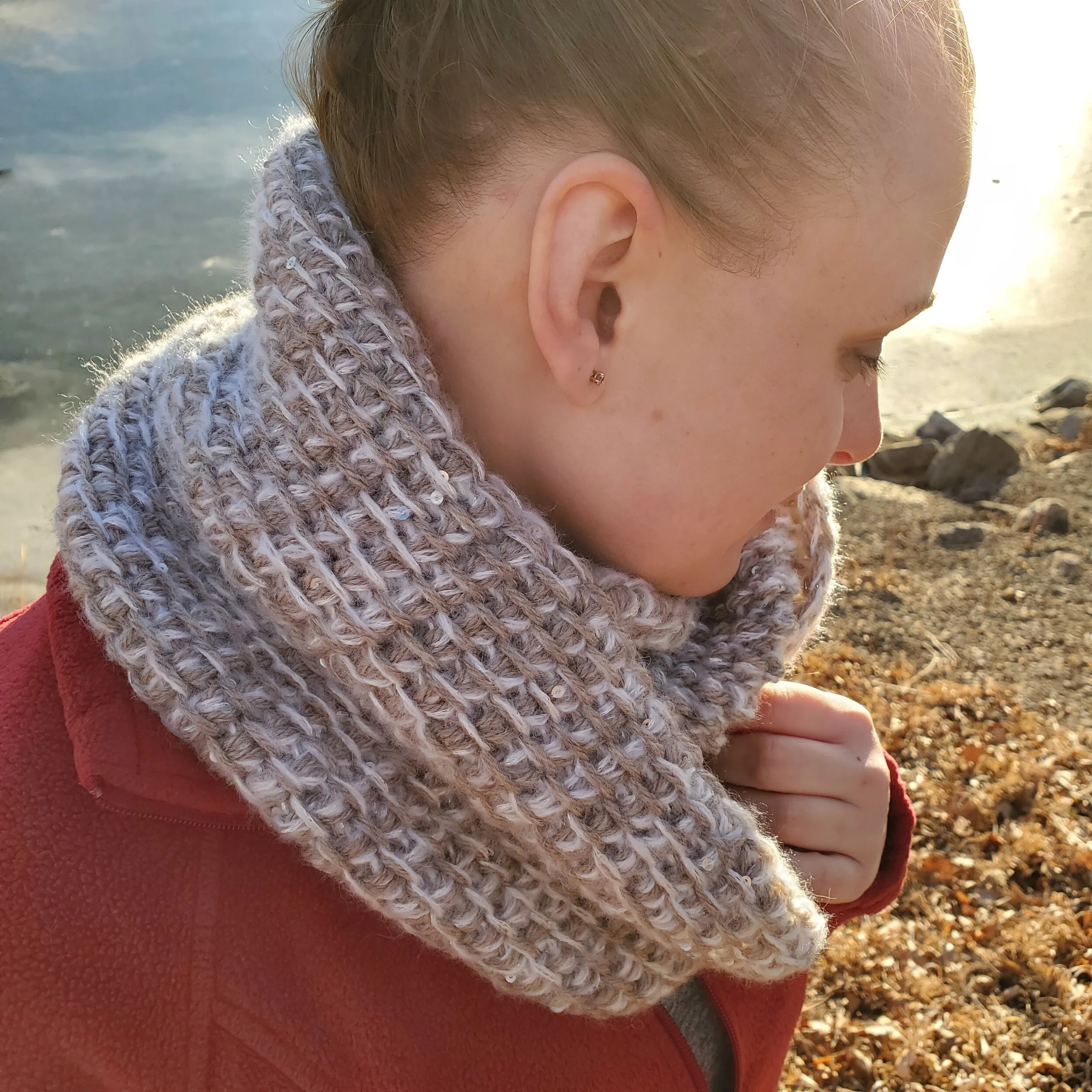
Row 1. Ch 18. Working in the back bumps (see Picture 1, below), pull up a loop in the second ch from hook, and each ch across. Work a RetP.
Row 2. Tss in each st across, Lts, RetP.
Repeat Row 2 until your work measures 64” long, or desired length.
Bind off row: Ch 1, *sl st next st (see Picture 2, below). Repeat from * until last st. Insert your hook as for Lts and pull up a loop. Yarn over and pull through both loops. Fasten off, leaving a 12” tail for seaming.

Blocking: You may wish to steam block or wet block your work prior to seaming.
To steam block, pin your work down to mats or another flat surface, taking care not to stretch the fabric. Use an iron or steaming tool, gently pass over the whole piece, applying steam to help relax the fibres. Leave pinned until dry.
To wet block, soak your work in cool water for 15-20 mins. Gently squeeze out excess water (do not wring!) by laying it flat on a towel and rolling it up tight. Lay the wet piece down on mats or a towel, and secure the edges with pins. Take care not to stretch your work; you can use the finished measurements as a guide. Leave pinned until dry.
Seaming: Fold your work so that the two short edges are matched up. Seam the edges together using your preferred seaming method (I like to use the Mattress Stitch technique). Weave in all ends.
To make your scarf narrower or wider, start with fewer or more chain sts in Row 1.
To make your scarf shorter or longer, work as many rows as you wish to achieve desired length.
To make a traditional long scarf, simply omit the seaming to leave your scarf open. Add tassels or fringe to take it to the next level!
Congratulations on finishing your Winter Sparkle Scarf! I hope you have enjoyed this quick and easy Tunisian crochet pattern. Share your pics on social media and tag me @capital.crochet and use the hashtag #WinterSparkleScarf.
You may sell finished items made from this pattern, but please credit me as the designer by linking back to this blog post.
Thank you so much for your support! Make sure to check out the other Winter Sparkle patterns in the series: Ear Warmer, Cowl and Mitts!
If you enjoyed this pattern, I thought you might be interested these similar Tunisian crochet scarf patterns, too! Shown below are the Stashdown Scarf (available FREE on the blog!) and the Juliet Cowl, available in my pattern shop, or on Ravelry and Etsy!
This post may contain affiliate links, meaning that if you click through and make a purchase, I earn a small commission at no extra cost to you. This helps support my business and makes it possible for me to bring you free content.
Hello friends! Welcome to the third pattern in the Winter Sparkle series - the Winter Sparkle Mitts!
Towards the end of November, when the days started to get real short and dark, I was sitting in my craft room one gloomy afternoon. I felt bleh, you know, lots I should be doing, no motivation to do anything. Yeah, that was me. Up on my shelf, I caught a glimpse of some Winter Nights yarn and thought, heck yes, gimme some sparkle!

The Winter Sparkle patterns are really fun, because they use two yarns held double to create a unique texture and colour look. The Winter Sparkle Mitts work up quickly, making them a great last-minute gift item that you can whip up whenever you need something in a flash. They also pair well with other free patterns from the series, like the Winter Sparkle Ear Warmer.
I used Lion Brand Winter Nights for the sparkly yarn, and paired it with Lion Brand Touch of Alpaca. This gives the cowl warmth and comfort.
The pattern uses the Tunisian Simple Stitch, which is the basic Tunisian crochet stitch. It is the perfect stitch to introduce yourself to the fabulous world of Tunisian crochet!
Hook - US 10mm, or size needed to meet gauge, and a short cord attached. I love these interchangeable hooks and cords from WeCrochet.
Yarn - Lion Brand Touch of Alpaca (I used the colour Oxford Grey) and Lion Brand Winter Nights (I used the colour Chinchilly). You will need approx. 90 yds of each yarn. You may also combine any two worsted (4) weight yarns, or use a bulky (5) yarn on its own, as long as you can meet gauge.
Notions - scissors, tape measure, yarn needle.
This pattern uses standard US terms as detailed by the Craft Yarn Council:
Ch - chain
St(s) - stitch(es)
Sl st - slip stitch
Inc - increase (pull up a loop in the back bar of the stitch. The next regular tss will be worked in the front bar of the same st, see Special Stitch section)
Tss - Tunisian Simple Stitch (see HERE for an excellent tutorial!)
Lts - Last Tunisian Stitch (insert hook under both bars)
RetP - Return Pass (Ch 1, *yarn over, pull through 2 loops. Repeat from * until 1 loop remains on your hook)
Gauge - 4” = 8.5 sts x 8 rows in tss unblocked.
Finished measurements - approximately 8.5" long x 4.5” wide at the thumb.
Curling at the top and bottom edges of Tunisian crochet is common. See the Finishing section below for blocking instructions to help tame the curl.
These mitts have been designed in one size, to fit a hand that is approximately 8” circumference at the bottom of the fingers. To adjust the size, see the Variations section at the end of the pattern.
Increase - use this internal increase technique to create a bit of a gusset for your thumb. Work
The top picture shows the detail of the back (1) and front (2) bar of the next st that you will work into.
The bottom picture shows the extra st (1) created for the increase, and the next regular tss st (2) worked into the front bar as per normal.

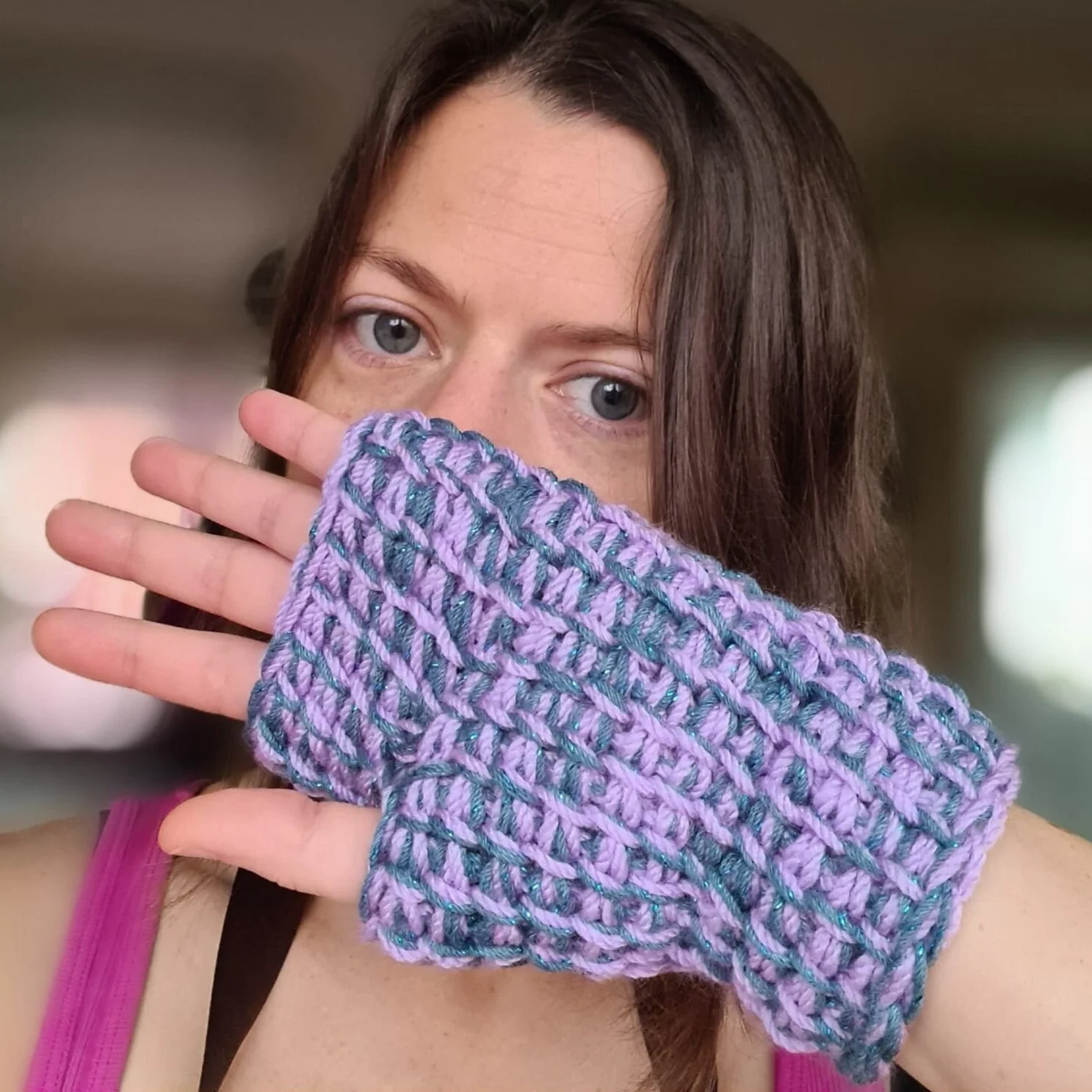

Row 1. Ch 18. Working in the back bumps (see Picture 1, below), pull up a loop in the second ch from hook, and each ch across. Work a RetP.
Rows 2-5. Tss in each st across, Lts, RetP. (18 sts)
Row 6. Tss 7, inc, tss, inc, tss 8, Lts, RetP. (20 sts)
Rows 7-11. Tss in each st across, Lts, RetP. (20 sts)
Row 12. Tss 7, sl st bind off (see Picture 2, below) next 5, tss 6, Lts. You should have 15 loops on your hook, with 5 sts bound off in the middle. Work a RetP, pinching the two groups of sts together to create the thumb hole where the 5 bound off sts are (see Picture 3, below). (15 sts)
Row 13. Tss 5, inc, tss, inc, tss 7, Lts, RetP. (17 sts)
Rows 14-16. Tss in each st across, Lts, RetP. (17 sts)
Bind off row: Ch 1, *sl st next st. Repeat from * until last st. Insert your hook as for Lts and pull up a loop. Yarn over and pull through both loops. Fasten off, leaving a 10” tail for seaming.
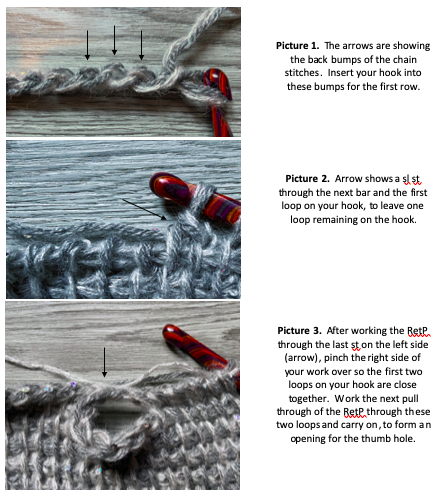
Blocking: You may wish to steam block or wet block your work prior to seaming.
To steam block, pin your work down to mats or another flat surface, taking care not to stretch the fabric. Use an iron or steaming tool, gently pass over the whole piece, applying steam to help relax the fibres. Leave pinned until dry.
To wet block, soak your work in cool water for 15-20 mins. Gently squeeze out excess water (do not wring!) by laying it flat on a towel and rolling it up tight. Lay the wet piece down on mats or a towel, and secure the edges with pins. Take care not to stretch your work; you can use the finished measurements as a guide. Leave pinned until dry.
Seaming: Fold your work so that the two side edges are matched up, with the thumb hole opposite. Seam the edges together using your preferred seaming method (I like to use the Mattress Stitch technique). Weave in all ends.
To make your mitts narrower or wider, start with fewer or more chain sts in Row 1.
To make your mitts longer down your arm, work more rows before working Row 6.
To make your mitts taller to cover more of your fingers, work more rows after Rows 14-16, before working the bind off row.
Congratulations on finishing your Winter Sparkle Mitts! I hope you have enjoyed this quick and easy Tunisian crochet pattern. Share your pics on social media and tag me @capital.crochet and use the hashtag #WinterSparkleMitts.
You may sell finished items made from this pattern, but please credit me as the designer by linking back to this blog post.
Thank you so much for your support! Make sure to check out the other Winter Sparkle patterns in the series: Ear Warmer, Cowl and Scarf!
If you enjoyed this pattern, I thought you might be interested these similar Tunisian crochet patterns, too! Shown below are the Bonfire Mitts and the Juliet Cowl, both available in my pattern shop, or on Ravelry and Etsy!
This post may contain affiliate links, meaning that if you click through and make a purchase, I earn a small commission at no extra cost to you. This helps support my business and makes it possible for me to bring you free content.
Well folks, it is officially Winter, because it SNOWED for the first time this year while I was outside taking pics for this pattern. It’s a good thing this latest pattern is thick and cozy, because I think those warm Fall days are behind us now…
I have really enjoyed Scarftober, and I hope you have too. I’m definitely thinking this should be an annual thing - what do you say? In case you missed them, check out the other two free patterns from earlier this month, the Cozy Clusters Infinity pattern, and The Diamond Scarf pattern. This new one, the Stashdown Scarf, just might be my favourite!
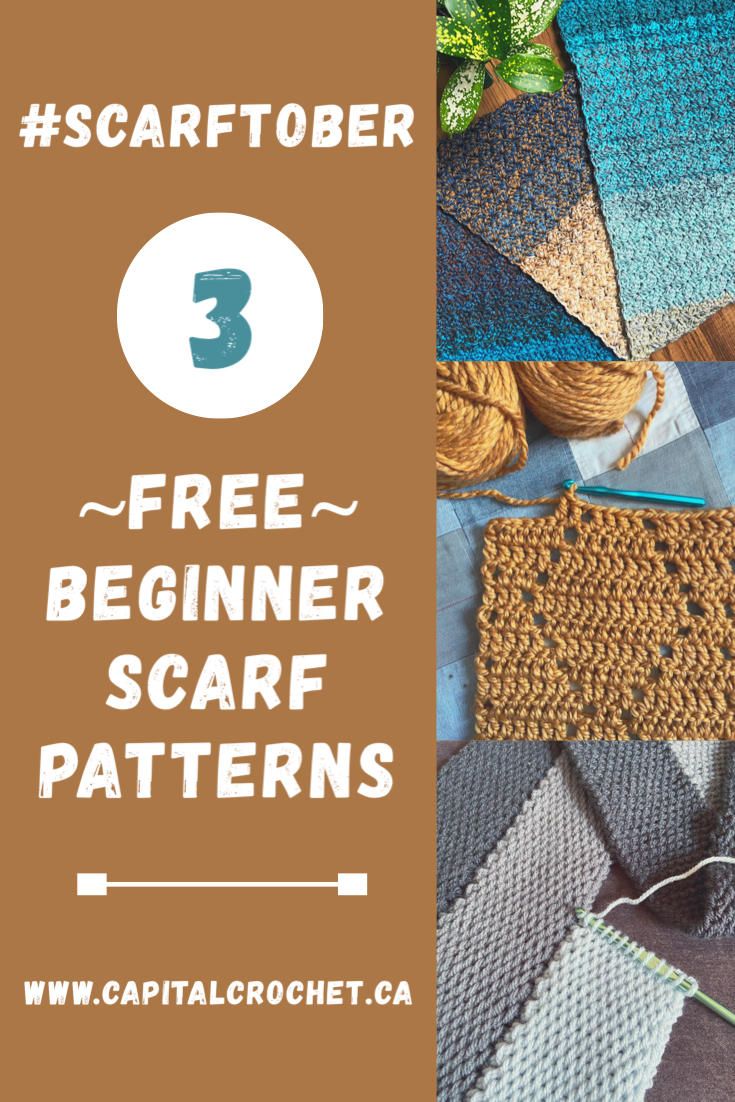
I love a good stashbusting pattern, don’t you? The Stashdown Scarf is an easy, repetitive pattern that is completely customizable. It’s perfect for clearing some space on your shelves so you can finally treat yourself guilt-free to a sweater quantity at your favourite dyer’s next shop update (this may or may not be EXACTLY what I plan to do). I’ve used worsted weight here, but you can use whatever you have!

Look at that SQUISH! This stitch pattern really creates a warm and cozy fabric, no matter what size yarn you use. Now, this is a Tunisian crochet pattern, but if you’ve never tried this craft before, fear not! You won’t need any special hooks, and I’ve linked below to my favourite videos from the Queen of Tunisian herself, Toni at TL Yarn Crafts! Take a few minutes to get familiar with the Tunisian Full Stitch and the Join As You Go technique, then come on back when you’re ready to get started.
Learn the Tunisian Full Stitch from start to finish in this quick crochet tutorial. WHAT YOU'LL LEARN: -Foundation forward and return pass -Two row repeat of...
Expand your Tunisian crochet skills by learning to add panels as you go! This is a great skill to learn for creating beautiful blankets, like my Temperature ...
I do plan to offer an ad-free, printable pdf version of the pattern very soon but for now, follow along below for the beginner-friendly directions, and get started on your very own Stashdown Scarf today!
Hook - US J/6mm, or size needed to meet gauge.
Yarn - 3 different colours of worsted (4) weight, approximately 280 yds each.
Notions - scissors, tape measure, yarn needle, 9” piece of cardboard or book to make the fringe.
Optional - blocking mats and pins.
Gauge - 7 sts x 7 rows = 2” in Tunisian Full Stitch.
Finished measurements - approximately 72” long x 9.5” wide (not including fringe).
This pattern uses standard US terms as detailed by the Craft Yarn Council:
Ch - chain
St(s) - stitch(es)
Sl st - slip stitch
Tfs - Tunisian Full Stitch (see tutorial video above)
Lts - last Tunisian stitch (insert hook under both loops of the edge stitch and pull up a loop)
RetP - Return Pass
This pattern is worked in 3 “strips.” The first strip is worked in regular tfs. The second and third strips are joined onto the side of the previous strip - no seaming in this pattern, my friends! For a great tutorial on the Join As You Go method, see the video above.
The first loop on the hook counts as the first stitch for each row.
For the first strip, the RetP is worked as follows: Ch 1, *yarn over and pull through 2 loops on hook. Repeat from * until 1 loop remains.
For the second and third strips, the RetP is worked as follows: Join with a sl st to the edge of the previous strip. *Yarn over, pull through 2 loops on hook. Repeat from * until 1 loop remains.

Row 1. Ch 12 and turn. Working into the back bumps of the ch sts, and starting in the second ch from hook, pull up a loop in each back bump (12 loops on hook). Work a RetP.
Row 2. Starting in the first space (between the first and second sts), tfs 10. Skip the last space, Lts and work a RetP.
Row 3. Skip the first space, tfs 10, Lts and work a Ret P.
Alternate Rows 2 and 3 until your work measures approximately 71” long (end on a repeat of Row 3).
Last row (bind off): Ch 1, starting in the first space, *insert hook as for tfs and pull up a loop. Yarn over, pull though both loops on the hook. Repeat from * in each space until one space remains. Skip the last space, insert hook into the last stitch as for Lts, yarn over and pull through both loops on the hook. Fasten off and weave in ends.
Row 1. Attach yarn at the bottom right corner of the previous strip, ch 12 and turn. Working into the back bumps of the ch sts, and starting in the second ch from hook, pull up a loop in each back bump (12 loops on hook). Join with a sl st to Row 1 of the previous strip and work a RetP.
Row 2. Starting in the first space (between the first and second sts), tfs 11. Join with a sl st in the side of the first st of the next row on the previous strip and work a RetP.
Row 3. Skip the first space, tfs 11. Join with a sl st in the side of the first st of the next row on the previous strip and work a RetP.
Alternate Rows 2 and 3 until you’ve joined to each row of the previous strip, minus the last (bind off) row.
Last row (bind off): Ch 1, starting in the first space, *insert hook as for tfs and pull up a loop. Yarn over, pull though both loops on the hook. Repeat from * in each space until one space remains. Skip the last space, join with a sl st to the ch st of the previous strip’s last row. Fasten off and we in ends.
Prior to adding the fringe, you may wish to block your work to straighten things out (sometimes Tunisian crochet tends to lean a little bit). Block your scarf according the fibre you’ve used - either wet block or steam block. Once your scarf is dry, you can move on to attaching the fringe.
To create the fringe, wrap yarn loosely but securely around your piece of cardboard or book. You don’t want any slack in your wraps but you also don’t want it to be stretched tight. Cut your wrapped yarn along one end only. You will need 216 pieces of yarn approximately 18” in length. I chose to do my fringe colour blocked and matching my strips, meaning I used 36 pieces of each colour per end. Feel free to mix up your colours!
Insert your hook into the first stitch on one of the short ends, and grab 3 strands of fringe with your hook. Pull a loop through, then pull the ends of the fringe through the loop. Cinch it down to tighten the fringe. Repeat in each stitch across both short ends of your scarf. Trim your fringe as needed, and you may wish to steam it to straighten out the strands.
Make an infinity scarf by omitting the fringe and seaming the short ends together to form a big loop.
Try different yarn weights and fibre content for a lighter or thicker scarf.
Adjust the length by working fewer or more rows of each strip. Adjust the width of your scarf by adjusting the number of strips, or the number of chain stitches in Row 1 of each strip. You can even make them uneven for an abstract effect.
Try variations on the fringe by making your pieces shorter or longer, or by placing fringe in every other or every third stitch. Leave the fringe off completely if it’s not your thing, or try tassels or poms!

Congratulations on finishing your fabulous new Stashdown Scarf! Share your pics on social media and tag me @capital.crochet and use the hashtag #StashdownScarf.
You may sell finished items made from this pattern, but please credit me as the designer by linking back to this blog post.
Thank you so much for your support!
Hey, Stashbuster! If you are looking for more patterns to help you work through your glorious yarn stash, check out these helpful patterns. Shown below are the Stashdown Blanket and Stashdown Pillow, available in my pattern shop, or on Etsy and Ravelry. Check out the Stashdown Blanket as a FREE pattern here on the blog, too!
Happy crocheting, friends!


Anyone else have an enormous stash of Bernat Blanket yarn? I literally had a drawer full of odds and ends - leftovers from my many Homebody Slippers that I’ve made as gifts and to sell at markets over the years. Since 2020 is the Year of the Stashdown, I decided to put all those balls into play in a fun and colourful pattern that can be completely customized to suit your stash!

My love affair with Tunisian crochet began around this time last year. It is so cool to see the world of new textures that opens up to you, and I promise it is much easier than it looks. This pattern uses the Tunisian Simple Stitch, which is the basic stitch technique and the easiest for a beginner to learn. If you need a tutorial on the Tunisian Simple Stitch, there are many available for free on youtube!
Below, you’ll find the free written pattern to make your very own Stashdown Blanket. If you prefer a printable pdf, a low-cost version of this pattern is available for download on Ravelry.
Size Q/16.00mm standard crochet hook (no special hooks required!)
Yarn – Bernat Blanket yarn, yardage varies from 550 for Baby size to 5200 for King size
Scissors
Tape Measure
Yarn Needle
This pattern uses standard American (US) terms:
Ch - chain
St(s) - stitch(es)
Sl st - slip stitch
Tss - Tunisian Simple Stitch
Slip stitch bind off - insert hook into next st, pull up a loop and pull through 1 loop on the hook. Repeat across the row and fasten off.
Gauge – 7 sts x 5.5 rows = 4” in Tss
Gauge is not super important for this pattern, however, I have used it as the standard for all the different blanket sizes.
Here are some standard sizes and approximate row and strip counts to achieve them. Of course, you may make this a truly scrappy stashbuster by just making until all your yarn is used up!

This pattern uses the Join-As-You-Go method. If you are not familiar with this technique, TL Yarn Crafts has a great tutorial!
The return pass is worked as follows: *yarn over and pull through 2 loops. Repeat from * until 1 loop remains on the hook.
I prefer to change colours at the end of a return pass. To do it this way, pull through the last two sts of the return pass with the new colour yarn. Feel free to change colours whenever you please to get a colour pattern that is totally unique!
If you’re working your blanket with scraps and doing many colour changes, I recommend weaving in your ends after each strip. I learned the hard way that waiting until you’ve made 7 strips makes for SO MANY ENDS to weave in all at once!
This pattern has been designed to use Bernat Blanket yarn which is a 100% polyester Super Bulky (6) weight yarn. Using a different brand or fibre content may produce different results and measurements.

Row 1. Ch 7 and turn. Starting in the second ch from hook, pull up a loop in the back bumps of each st (7 loops on hook). Ch 1 and work a return pass.
Row 2. Tss in each st across (7 loops on hook). Ch 1 and work a return pass.
Repeat row 2 to the desired length (see chart above for standard blanket sizes and approximate row counts), making colour changes whenever you please. Tip: I prefer to make my colour changes at the end of a return pass to keep the rows neat and tidy.
When you’ve got your strip to the desired length, work a slip stitch bind off row.
Now it’s time to start your next strip.
Row 1. Join your yarn to the bottom of the first row of your first strip. Ch 7 and turn. Starting in the second ch from hook, pull up a loop in the back bumps of each st (7 loops on hook). Sl st into the side of the first row on your first strip to join (this counts as your ch 1) and work a return pass.
Row 2. Tss in each st across (7 loops on hook). Sl st into the side of the next row on your previous strip (this counts as your ch 1) and work a return pass.
Repeat row 2 for the same number of rows as your previous strip. Work a slip stitch bind off row to finish off and start again on your next strip. Refer to the sizing chart for number of strips to work to achieve the desired size.
My Stashdown Blanket uses scraps and tidbits, but you can certainly make this blanket with more of a plan. You can plan each colour change after a certain number of rows (I’m picturing a checkerboard!), or work full strips in solid colours for bold stripes. You can even change the number of stitches in each row to create wider or narrower strips! The creative possibilities are endless and I would love to see what you come up with.
Make sure to use #StashdownBlanket and tag me @capital.crochet when you share your blankets on Instagram! You can also add your project to Ravelry HERE.
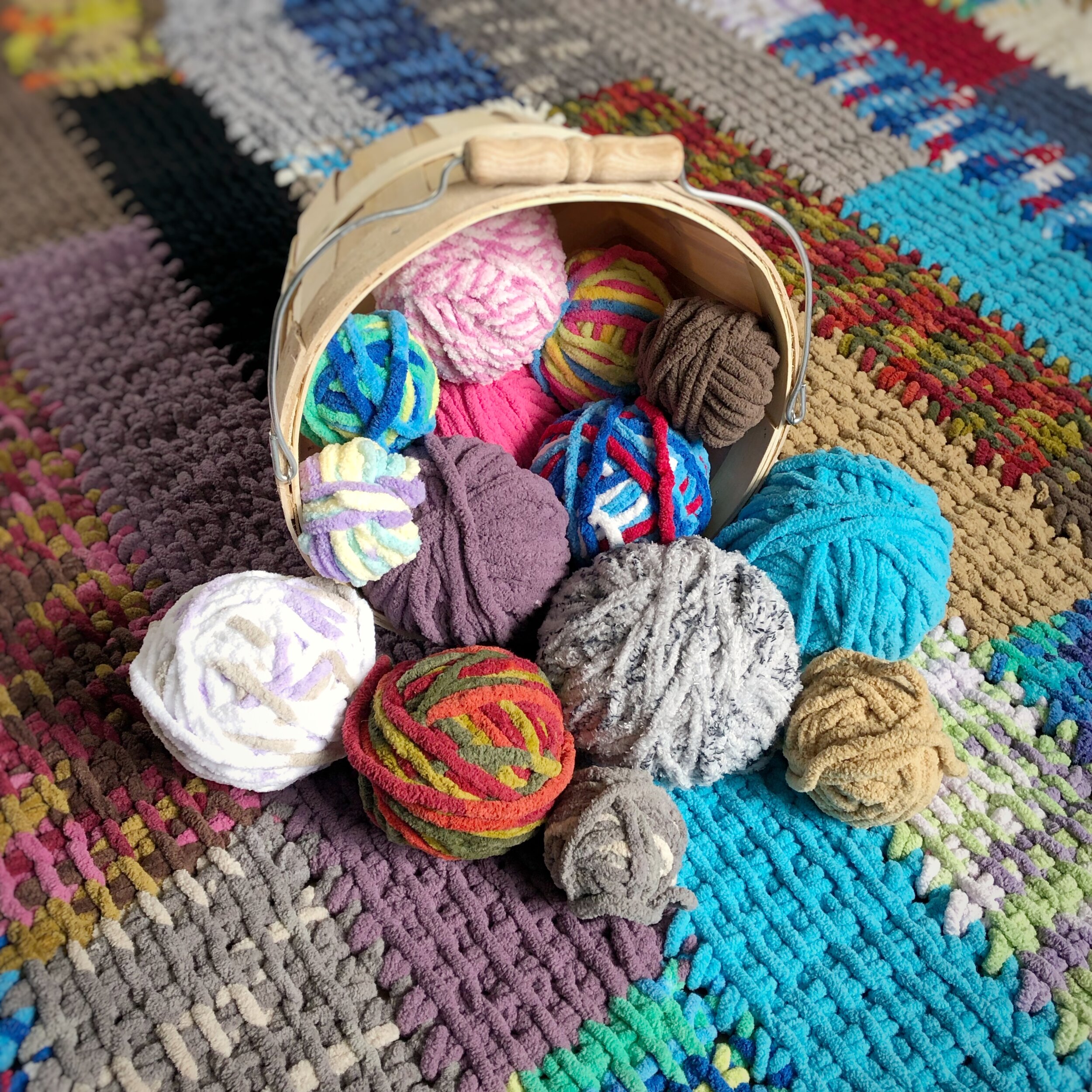
If you like working with this yarn, I invite you to check out my Homebody Slippers and Cozy Spa patterns. They also use smaller amounts of Bernat Blanket yarn, and are great instant gratification projects.

I hope you enjoy this stashbusting project, and thank you so much for crocheting along!

I’m very excited about today’s post - I’m participating in the Easy Tunisian Crochet Blog Hop hosted by Noorain of Noor’s Knits! It’s my first time doing a blog hop, and I’ve learned so much. All the patterns featured are Tunisian crochet, but you can make them with a regular crochet hook! A new pattern is released EVERY day from Monday to Friday as a FREE download available for 24 hours only. The patterns featured are perfect projects to try your hand at Tunisian crochet.
Today’s featured pattern is my Stashdown Pillow. It’s the perfect project for using up all your worsted weight scraps! It’s worked with a regular crochet hook, using the Join-As-You-Go method. It may sound complicated, but once you get the hang of it you’ll be busting that stash in no time! You can download this pattern for FREE until 11:59 pm EST tonight on Ravelry using the code that can be found on the main blog post HERE.
This pattern is a special one for many reasons. First, it’s Tunisian crochet which I am currently obsessed with. It’s becoming so popular among yarnies, and I know it is on many of your “to try” lists.

This pattern is a great way to try your hand at the “Join As You Go” method, meaning you don’t need a long cord or special hook to make a bigger project. It’s also a great stashbuster, and as you can see I’ve chosen a bunch of different yarns from my stash.
I kept it consistently random (if that makes sense!) meaning I varied the size of each colour block but spaced out all the colours so that they seem fairly evenly distributed. I’d love to see you put your own spin on this project, maybe choosing a rainbow of colours, going for a monochrome look, working solid stripes or whatever genius idea you can think of! Make sure to tag me on Instagram and use the hashtag #StashdownPillow.
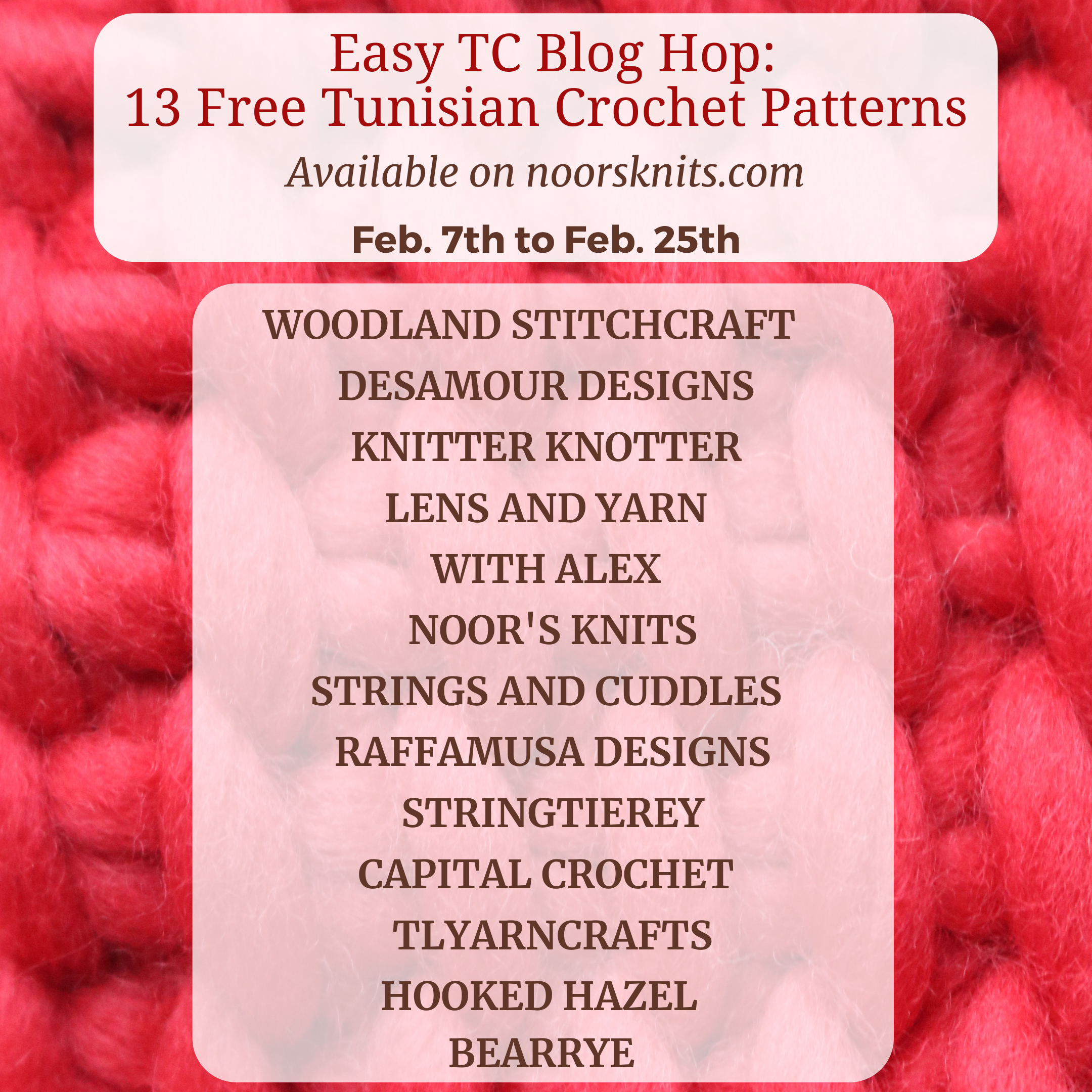
I’m not going to lie, Tunisian crochet tends to eat up more yarn than similar-sized regular crochet patterns. But that means you can put to use a good portion of your stash while making a beautiful and useful piece of home décor. I’m all about stashbusting lately, and if you’re taking part in #Stashdown2020 (read more about that HERE), this is an excellent pattern to have in your library.
Be sure to follow along with Noorain’s blog Noor’s Knits to see the newest featured pattern for this month’s blog hop and don’t forget to use #EasyTC And tag @noorsknits to share your projects on Instagram for a chance to win some great prizes! Thanks so much for following along and I hope you really enjoy these beginner Tunisian projects.

Hi friend! I’m Janine, the maker behind Capital Crochet. Thanks for stopping by my little corner of the fibre arts community!
Powered by Squarespace. Copyright 2024 Capital Crochet. All rights reserved.
All photos and content are property of Capital Crochet unless otherwise stated and may not be copied, in part or in whole, without consent. This site uses third party advertising and affiliate links, meaning that a small commission may be earned at no additional cost to you.